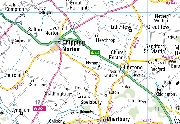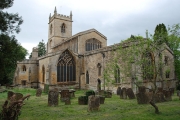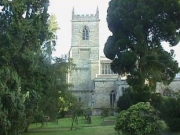Chipping Norton, Oxfordshire
And Over Norton
Born here:
Charles Cross (1847), Daniel Cross (1851), Lotty Jane (1856)Died here:
Henry Cross, Augustine Cross.Chipping Norton today:
Chipping means a market and in the middle ages people came to buy and sell at the markets and fairs that gave Chipping Norton its name.The town has grown outwards around the original mediaeval Market Square. There is still a weekly market every Wednesday and the "Mop Fair" (once a hiring fair for servants) in September.
Chippy began as a few houses with a church and a castle at the bottom of the hill. Only the earthworks of the castle still remain but the church is now a fine example of a "wool church", enlarged by local merchants who grew rich on the profits of the Cotswold wool trade. To promote increased trade, a new market place was laid out in about 1205 surrounded by the houses and shops of the wealthier inhabitants, and this formed a new town centre higher up the hillside - where it still is today.
In later centuries sheep farming was largely replaced by arable, but agriculture remained important in this part of the Oxfordshire Cotswolds. Around the market place many of the original houses were rebuilt in the 18th century with fashionable "Georgian" fronts, which are still an impressive sight when you look along the High Street above the modern shops. Earlier styles remain in New Street - which is actually very old! Travellers have always stopped in Chipping Norton and there were plenty of hotels and inns for cater for them. In Victorian times William Bliss built his spectacular tweed mill (see Photo 2). Today it houses upmarket apartments but still retains the attractiveness of the exterior. There was a brewery, a glove making factory, a tannery and an iron foundry, and the town grew in size.
This old Cotswold stone town remains a flourishing centre with a strong sense of community, proud of its past but not living in it.1
Chipping Norton in 1831:
The following is an extract taken from from Lewis's Topographical Dictionary of England, 1831.1
Norton (Chipping), a market town and parish, having exclusive jurisdiction, though locally in the hundred of Chadlington, county of OXFORD, 18 miles (N.W.) from Oxford, and 73 (N.W. by W.) from London, containing, with the hamlet of Over Norton, 2640 inhabitants.
The prefix Chipping is a corruption of Ceapan, a market, or place of trade, Norton implying the north town, from which it appears to have been a place of some note during the Saxon era.
The streets are partially paved and lighted, and there is a plentiful supply of water. A woollen manufactory, which has existed here for some time, is now on the decline. The market is on Wednesday: fairs are held on March 7th, May 6th, the last Friday in May, July 18th, September 4th, the last Wednesday in September, November 8th, and the last Friday in November; there are also three statute fairs in October. The following large markets are for cattle; the last Wednesday in January, the second in April, June, and August, and the Wednesday next after December 11th.
The civil government is vested in two bailiffs and ten burgesses, who are chosen at the court baron held at Michaelmas; the bailiffs are justices of the peace, exercising exclusive jurisdiction within the borough; they hold a court of session for the trial and punishment of offenders. The petty sessions are held here; and there was formerly a court of record, held under a charter of James I., for the recovery of debts under £4, now disused.
The borough returned two representatives to parliament, once in the reign of Edward I., and twice in that of Edward III. The living is a discharged vicarage, in the archdeaconry and diocese of Oxford, rated in the king's books at £10. 6. 8., endowed with £200 parliamentary grant, and in the patronage of the Dean and Chapter of Gloucester. The church, which is dedicated to St. Mary, stands a little below the town, and exhibits specimens of exquisite workmanship, particularly in the middle aisle and the windows. There are places of worship for Baptists, the Society of Friends, and Methodists.
On the dissolution of the Trinity guild, in the 1st of Edward VI., the grammar school was re-founded, its former endowment of £6 per annum, which had long been paid out of the revenue of the guild, having been continued, and since paid at the Salt office, out of the land revenue belonging to the crown. A bequest of £300 was left by Francis Barnes, by will, dated May 21st, 1762, the income arising from which is about £17 per annum: out of this sum the master is bound to keep his residence (which is rent-free) and school in repair: he receives boarders: two boys, appointed by the corporation, are gratuitously instructed in the elements of English and classical literature, the rest pay seven shillings and sixpence each per quarter. The Lancasterian school for girls is supported by voluntary subscription.
Eight almshouses for poor widows, who are appointed by the bailiffs and burgesses, were built about 1649, by Henry Cornish, who, amongst other charities, also devised twelve cottages, on condition that they should always be let at the same moderate rent, for the residences of poor persons of good repute.In a part of the parish, called Cock's Town End, there are four almshouses for persons appointed by the corporation, which are repaired at the expense of the parishioners; but the origin of this charity is unknown.
An ancient monument, called Rowldrich, or Rollrich stones, is situated about two miles from the town: it originally consisted of sixty stones, now reduced to twenty-two, forming a circle thirty-five yards in diameter from the north to south, and thirty-three from east to west. Few of them exceed four feet in height, and sixteen inches in thickness, except one at the northern point, which is seven feet high, and five and a half broad. Eighty-four yards north-east is a large one, called the King stone, which is eight feet high, and seven broad, and about twelve inches in thickness. There are various conjectures as to the origin of this monument. Camden considers it to be a memorial of some victory, erected probably by Rollo, the Dane, who invaded England in 876; but Dr. Stukeley ascribes the work to the Druids, Rholdrwg signifying the cicle, or church of the Druids. He assigns the same origin to the several barrows near this spot, one of which is sixty feet long and twenty broad. Near this monument are four stones contiguous to each other, each of which is the boundary of a county, the several counties of Oxford, Gloucester, Worcester, and Warwick, terminating at this point.
At Cold Norton, in this parish, an Augustine priory was founded by William Fitz-Alan, in the reign of Henry II., and dedicated to the Virgin, St. John the Evangelist, and St. Giles, which having escheated to the crown in the reign of Henry VII., was purchased by Dr. William Smith, Bishop of Lincoln, and given to Brasenose College, Oxford.






